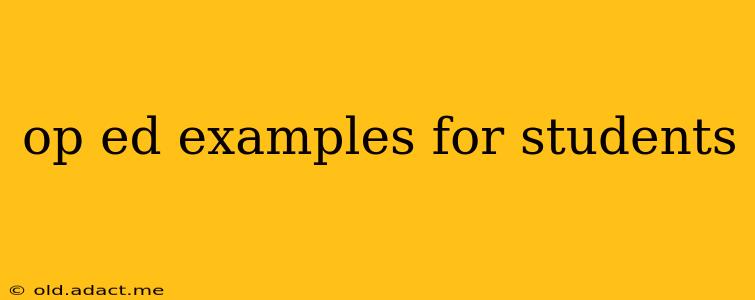Op-Ed Examples for Students: Mastering the Art of Persuasion
Op-eds, short for "opposite the editorial," are opinion pieces typically published in newspapers and online publications. They offer a platform for individuals to express their views on current events and issues. Mastering the art of writing a compelling op-ed is a valuable skill for students, enhancing critical thinking, persuasive writing, and public engagement. This guide provides examples and strategies to help students craft effective op-eds.
What Makes a Strong Op-Ed?
Before diving into examples, let's establish the key components of a successful op-ed:
- Clear Thesis Statement: The central argument should be stated concisely and early in the piece. This acts as a roadmap for the reader.
- Compelling Narrative: Engage the reader with a strong opening hook, perhaps an anecdote, statistic, or provocative question.
- Evidence-Based Reasoning: Support your claims with facts, statistics, credible sources, and relevant examples. Avoid generalizations and unsubstantiated assertions.
- Concise and Engaging Language: Use clear, concise language, avoiding jargon. Maintain a strong voice and style that resonates with your target audience.
- Counterarguments and Rebuttals: Acknowledge opposing viewpoints and address them directly with reasoned counterarguments. This demonstrates intellectual honesty and strengthens your position.
- Call to Action: Conclude with a clear call to action, urging readers to take specific steps or consider your perspective.
Op-Ed Examples Based on Common Student Topics:
Here are some hypothetical examples categorized by common student concerns:
1. Education Reform:
Title: The Crushing Weight of Standardized Testing: A Student's Perspective
Thesis: The overreliance on standardized testing in our education system stifles creativity, fosters anxiety, and fails to accurately assess student learning.
Example Argument: The essay could detail personal experiences with high-stakes testing, the pressure it creates, and how it distracts from more enriching aspects of education. Data on student stress levels and the limitations of standardized tests as accurate measures of learning could also be incorporated. The author could propose alternative assessment methods that focus on critical thinking and creativity.
2. Environmental Issues:
Title: Our Generation's Climate Crisis: Why We Must Demand Action Now
Thesis: The current generation must take responsibility for combating climate change by demanding systemic changes from governments and corporations, and by embracing sustainable practices in our daily lives.
Example Argument: The essay might begin with a compelling statistic about rising global temperatures or the impact of climate change on vulnerable communities. It could discuss the role of fossil fuels, unsustainable consumption, and government policies. The author could advocate for specific actions, such as transitioning to renewable energy sources, supporting climate-friendly policies, and promoting individual responsibility.
3. Social Justice Issues:
Title: Beyond the Hashtag: Real Action Needed to Combat Campus Sexual Assault
Thesis: While awareness campaigns around campus sexual assault are crucial, meaningful change requires systemic reform, improved support services for survivors, and stricter accountability for perpetrators.
Example Argument: The essay could highlight statistics on sexual assault on college campuses, personal stories (while maintaining anonymity), and the shortcomings of current campus responses. It could then propose concrete solutions such as improved reporting mechanisms, better training for campus officials, and comprehensive support programs for survivors.
4. Technology and Society:
Title: The Double-Edged Sword of Social Media: Connection and Isolation in the Digital Age
Thesis: Social media platforms, while offering valuable connection, also contribute to social isolation, mental health challenges, and the spread of misinformation. Responsible use and regulation are crucial.
Example Argument: The author could discuss the positive aspects of social media, such as connecting with friends and family across distances. However, they would also emphasize the negative impacts, such as cyberbullying, unrealistic comparisons, and the spread of false narratives. They could suggest solutions like promoting media literacy, regulating harmful content, and encouraging healthier online habits.
Frequently Asked Questions (PAAs):
Q: How long should a student op-ed be? A: Generally, student op-eds range from 500-800 words. However, specific length requirements may vary depending on the publication.
Q: What if I don't have a strong opinion on a particular issue? A: Start by researching topics that interest you. Reflect on your experiences and identify areas where you feel passionate or knowledgeable.
Q: How can I find places to submit my op-ed? A: Many college newspapers, online student publications, and local news outlets accept student submissions. Search online for "student op-ed submissions" or contact publications directly.
By following these examples and guidelines, students can develop strong, persuasive op-eds that effectively communicate their ideas and engage their audiences. Remember to always cite your sources and maintain academic integrity.
